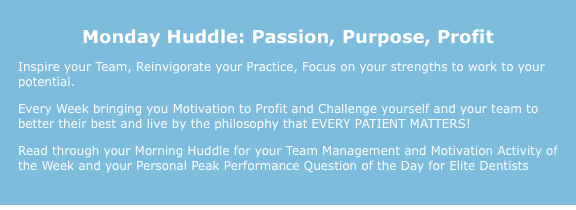If there were ever things to ignore, I can think of three really good ones that happen, oh say, about every single time a patient sits in your chair.
Literally every visit, every day.
That’s right, what I’m about to tell you today are three specific instances that you encounter more often than not. These tend to put an assumptive idea in your mind that results in you ignoring the best opportunities to find treatment, help patients get healthy and otherwise do something productive with your patient visits.
This is why I talk about the first rule of the day is to treat every patient as if they were a brand-new patient, as if you have never seen them before.
Because this is what leads to discovering things that will let you help the patient and allow you to show them to the big picture and educate them.
If you do not treat them as a new patient, you might take things for granted, become complacent or miss valuable engagement that would lead to breakthroughs for the patients you see.
Here you go, don’t take them lightly…
1st – Ignore any time you believe the patient has already said “no” to a suggestion, diagnosis or next step in the treatment plan or an idea from the past.
First of all, at best you see a patient again in 3-4 months, most 6 months and a lot can change. Furthermore, it is your job to continue educating and encouraging patients by SHOWING THEM how their mouths are progressing. The more you make the problems relevant to them, the more chance they will believe in you and want to fix them.
Bottom line: don’t be a wimp. The excuse that the patient has denied acceptance of the treatment in the past has nothing to do with today. Re-engage, shoot new photos and find a different want to bring it up.
2nd – Ignore the fact that there is a treatment plan or there is not a treatment plan in the system… if the doctor has supposedly diagnosed this patient before, don’t look at that at face value. You simply can’t rely on the computer, the charts, the former treatment plan. In most every case (and I mean almost every single case), there are things missing from the treatment plan. If there is not a detailed, comprehensive quadrant by quadrant full mouth phased in treatment plan – then you can pretty much be assured there are things that the doctor missed or failed to mention.
Any team member relying only on what is in the computer to begin with is missing the point and really negligent on their responsibilities. As I always point out, the doctor is with the patient the least amount of time. For the most part, the doctor’s treatment plan and diagnosis is only as good as the work up, records, x-rays and photographs the clinical team member has taken. On top of that, depending on the time allowed for the doctor, it could be rushed.
Bottom line: don’t assume what’s in the computer or the chart is all that is there. Look again with fresh eyes; every time.
3rd – and finally if you do nothing else, please for goodness sake – Ignore every patient who tells you no or they have to think about it or they want to know how much it is or how much insurance will cover. Do not let your patients try to play doctor.
I call this climbing over the first no. Everybody says no in one way, shape or form. That’s what humans do, they react with negatives. Don’t buy it. Stand firm, restate the goals, reassert the importance and ask again for the patient’s intentions to proceed with a healthy, proactive, preventative mindset and commitment to solve the problems that you have made evident in the patient’s mouth.
When you learn and hone your skill to habitually react to every no with a positive statement redirecting back to the point and purpose, you will win and patients will have more trust in you. You will be surprised how many say yes because you believe first in them and in what you have asked them to agree to.
Most people lose because they give up too easily…letting unhealthy patients walk out the door.
Don’t fall victim for these basic mistakes and train yourself to be assertive and alert. Whatever you do, learn to ignore these 3 major issues and at least dive in deeper into the diagnosis, into the patients’ mouths and their goals. Help your patients in spite of what has already been discussed or is perceivably known or decided.
If you want more specifics on this and influencing patients to buy life changing dentistry, I’ve released one of my most advanced provocative and in depth courses you can access directly here (this week only)…
The Ultimate High-Fee Case Accelerator >>>



